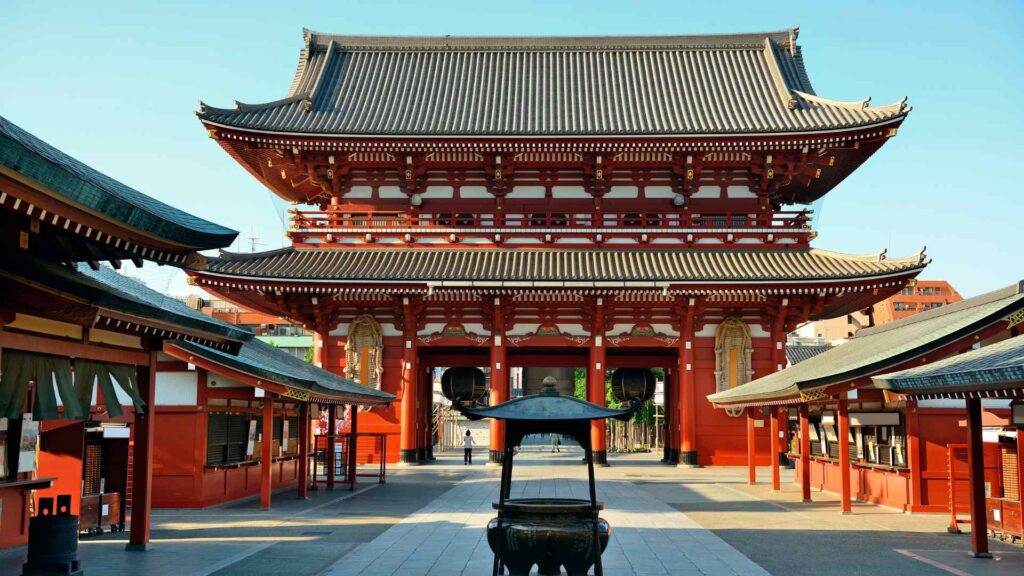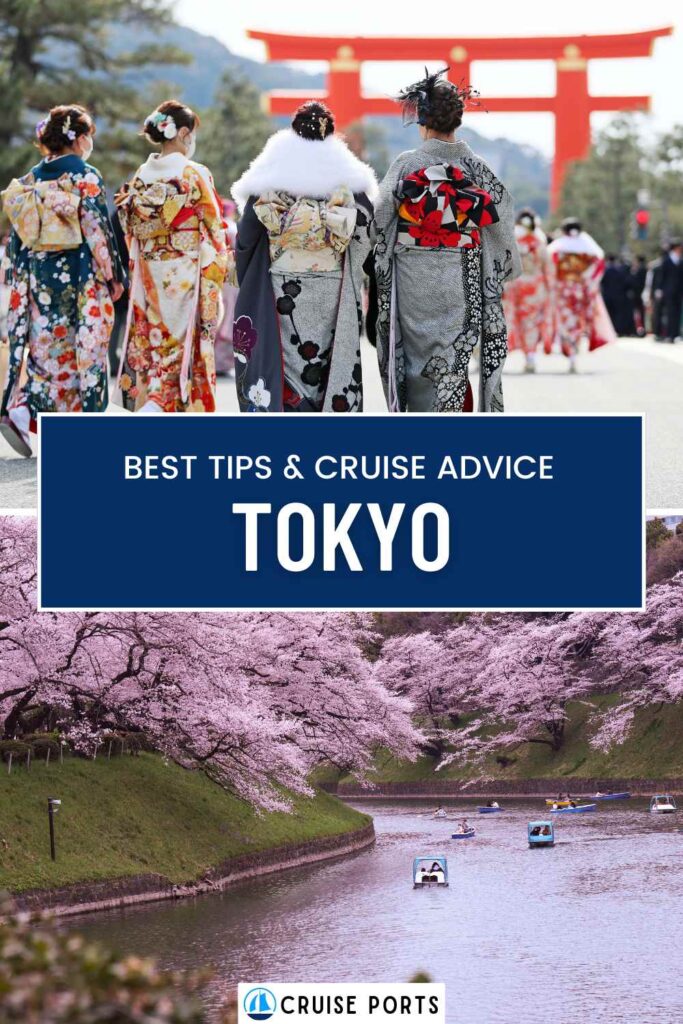When cruising to Japan, Tokyo often ranks high on travelers’ lists, and for a good reason. Tokyo offers an exhilarating mix of ancient traditions and cutting-edge modernity.
If your cruise ship docks in Tokyo, understanding Tokyo Cruise Port and how to navigate the city’s attractions will enhance your travel experience.
Introduction to Tokyo Cruise Port
Tokyo is served by two primary cruise ports: Harumi Cruise Terminal and the recently expanded Osanbashi Pier in Yokohama.
While Yokohama isn’t technically in Tokyo, it’s often used for Tokyo-bound cruises due to its proximity.
Both ports provide easy access to the heart of Tokyo, and understanding the differences between the two will help you plan your visit.

Harumi Cruise Terminal
Harumi Cruise Terminal is Tokyo’s principal port, located in the Tokyo Bay area.
It’s about a 30-minute drive from downtown Tokyo and offers easy access to key attractions such as Odaiba, the Tokyo Tower, and the Imperial Palace.
Harumi is smaller and less busy than some other Asian cruise terminals, which can make the arrival and departure process smoother for passengers.
However, its relatively limited size means that amenities like dining options or large waiting areas may be more restricted compared to major international ports.
Osanbashi Pier, Yokohama
Osanbashi Pier in Yokohama is Japan’s busiest and most significant international cruise terminal. It is located about 30 kilometers from Tokyo but is well-connected by train and bus services.
Many larger ships dock here, as it offers modern facilities, a large passenger lounge, and spectacular views of Yokohama’s skyline and Mount Fuji on clear days.
While you may need to travel a bit further to reach Tokyo, the cruise experience in Yokohama is smooth, and Yokohama itself is an exciting port city to explore with attractions like the Cup Noodles Museum, Yokohama Chinatown, and Sankeien Garden.
Getting From the Port to Tokyo
Once your cruise ship docks, you’ll need to figure out how to reach Tokyo’s bustling city center.
Both Harumi and Osanbashi Pier are conveniently connected to public transportation, offering cruisers multiple ways to reach Tokyo’s attractions.
From Harumi Cruise Terminal
Taxis: The easiest, though more expensive, option for getting into Tokyo from Harumi is by taxi. A taxi ride to central Tokyo costs around 3,500–5,000 yen (roughly $30–45 USD), depending on traffic.
Public Transport: For a more budget-friendly alternative, shuttle buses often run from the port to major train stations, such as Tokyo Station. From there, you can hop on the JR Yamanote Line to travel to popular districts like Shibuya, Shinjuku, and Ueno.
From Osanbashi Pier
Train: The quickest and most efficient way to reach Tokyo from Yokohama is by train. The Minatomirai Line connects Osanbashi Pier to Yokohama Station in just a few minutes.
From Yokohama Station, you can take the JR Tokaido Line or the JR Keihin-Tohoku Line to reach Tokyo Station in about 30 minutes.
Bus: Bus services are also available, though they’re slower than the train. If you’re traveling with a lot of luggage, a bus might be more convenient as it offers direct service without the need for transfers.

Tokyo’s Must-See Attractions for Cruisers
Tokyo is a sprawling metropolis with a wealth of sights, but cruisers often have limited time in port.
Here’s a breakdown of some of the top attractions that should be on your list, all of which are accessible within a day trip from the port.
The Tokyo Tower and Zojoji Temple
For those wanting to combine cultural and modern sightseeing, start your Tokyo visit with the Tokyo Tower, a famous landmark modeled after Paris’ Eiffel Tower.
Not far from the tower is Zojoji Temple, an impressive Buddhist temple that offers a tranquil escape from the city’s hustle and bustle.
The temple grounds are expansive and offer great photo opportunities with the Tokyo Tower in the background.
The Imperial Palace and East Gardens
Located near Tokyo Station, the Imperial Palace is the residence of Japan’s royal family.
While the inner grounds are generally off-limits, visitors can explore the beautiful East Gardens and admire the historic architecture of the palace’s bridges and moats.
Guided tours of the outer palace grounds are available, offering historical insight into Japan’s imperial past.
Shibuya Crossing
If you’re seeking the quintessential Tokyo experience, make your way to Shibuya Crossing.
Often called the busiest pedestrian crossing in the world, this area pulsates with energy and is surrounded by neon-lit skyscrapers and trendy shops.
From Shibuya, you can also visit Hachiko Statue, a popular meeting spot, and the towering Shibuya Scramble Square, offering panoramic views of the city.
Senso-ji Temple and Asakusa
If you’re drawn to Japan’s rich cultural heritage, head to the Asakusa district, home to Tokyo’s oldest and most famous temple, Senso-ji.
The temple grounds feature the iconic Kaminarimon Gate, Nakamise shopping street, and traditional Japanese tea shops.
This area gives you a glimpse into Tokyo’s past while still offering the energy of a bustling marketplace.
Odaiba
Odaiba, an artificial island in Tokyo Bay, offers a blend of entertainment, shopping, and stunning waterfront views.
Attractions like the teamLab Borderless digital art museum, DiverCity Tokyo Plaza, and the Oedo-Onsen Monogatari hot spring theme park make Odaiba a fantastic place to relax and explore.
The futuristic architecture and the Rainbow Bridge make it a popular spot for photography.

Navigating Tokyo’s Public Transport
Tokyo’s public transport system is incredibly efficient, but it can be overwhelming for first-time visitors due to its size. With a little preparation, however, it’s easy to get around.
Using the JR Yamanote Line
The JR Yamanote Line is a circular line that connects many of Tokyo’s key districts, such as Shinjuku, Shibuya, and Ueno.
If you’re limited on time, using this line allows you to visit some of Tokyo’s most famous areas without worrying about complicated transfers.
Tokyo Metro
Tokyo also has an extensive metro system operated by two main companies: Tokyo Metro and Toei Subway.
These lines crisscross the city and provide access to areas that the JR Line doesn’t cover, such as Ginza and Roppongi.
Consider purchasing a Tokyo Subway Ticket, which offers unlimited metro travel for 24, 48, or 72 hours, perfect for short stays.
PASMO and Suica Cards
To make using public transport even easier, purchase a PASMO or Suica card at any train station. These prepaid cards can be used on trains, subways, buses, and even at convenience stores.
They eliminate the need to buy individual tickets for each ride, saving you time and hassle.
Best Shopping Districts Near Tokyo Port
Shopping in Tokyo is an unforgettable experience. Whether you’re hunting for luxury goods, quirky souvenirs, or traditional Japanese crafts, there’s a district for you.
Ginza
Ginza is Tokyo’s high-end shopping district, home to flagship stores for global luxury brands like Chanel, Dior, and Louis Vuitton.
Alongside designer boutiques, you’ll also find traditional Japanese department stores like Mitsukoshi and Wako.
Ginza offers a mix of the old and new, and its main street is pedestrianized on weekends, making it a shopper’s paradise.
Akihabara
For tech enthusiasts and pop culture fans, Akihabara is a must-visit. Known as Tokyo’s “Electric Town,” this area is packed with electronic stores, anime shops, and gaming arcades.
Whether you’re looking for the latest gadgets or rare anime merchandise, Akihabara’s vibrant energy will captivate you.
Nakamise Street in Asakusa
If you’re after traditional Japanese souvenirs, head to Nakamise Street, located near Senso-ji Temple in Asakusa.
Here, you’ll find stalls selling everything from kimono fabric to handmade fans and street food like taiyaki and senbei crackers. It’s a great place to pick up authentic mementos of your trip.
Eating in Tokyo: Must-Try Foods for Cruisers
Japanese cuisine is world-renowned, and Tokyo offers some of the best dining experiences, whether you’re after high-end sushi or casual street food.
Sushi in Tsukiji Outer Market
For the freshest sushi, head to the Tsukiji Outer Market.
While the inner wholesale market has moved to Toyosu, the outer market still thrives and offers an incredible selection of seafood stalls, sushi restaurants, and street food vendors. Enjoy a sushi breakfast or snack on fresh sashimi as you explore the market.
Ramen in Shibuya
Tokyo is home to some of Japan’s best ramen shops. In Shibuya, you’ll find many famous ramen joints like Ichiran and Ippudo, offering rich broth, tender noodles, and a variety of toppings.
Ramen shops often have vending machines where you order your meal in advance, making the process quick and easy.
Tempura in Asakusa
For a taste of traditional Japanese cuisine, try tempura in Asakusa. Tempura is battered and fried seafood or vegetables, typically served with dipping sauce or on top of rice.
Asakusa is famous for its old-fashioned tempura restaurants, where you can enjoy this crispy delicacy in a cozy, nostalgic setting.
Important Tips for Cruisers in Tokyo
- Plan Your Time Wisely: Tokyo is a vast city, and traffic can be heavy at times. Make sure you plan your itinerary in advance to maximize your time in port.
- Learn a Few Japanese Phrases: While Tokyo is tourist-friendly and many people speak English, learning a few basic Japanese phrases can enhance your experience.
- Use ATMs for Cash: Japan is still a largely cash-based society, especially in traditional markets and smaller shops. ATMs that accept international cards can be found in convenience stores like 7-Eleven and FamilyMart.
- Consider Luggage Services: If you have heavy luggage, Japan offers takkyubin (luggage forwarding) services. You can send your bags from the port to your hotel or even to the airport, freeing you up to explore Tokyo more comfortably.
- Stay Connected: Tokyo has excellent Wi-Fi coverage, but for constant connectivity, consider renting a pocket Wi-Fi device at the port or your hotel.


